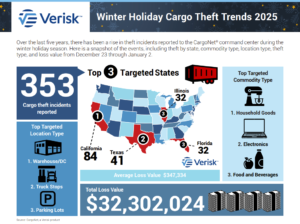There was little change to the numbers of new Class 8 trucks sold on the U.S. market in November. The “good news/bad news” freight market continued as freight rates were propped up by an inability to add trucks.
U.S. sales of 17,021 new Class 8 trucks in November represented a decline of 2.7% from October sales of 17,486, according to data received from ACT Research. In a typical year, November isn’t a strong sales month; it’s not the final month of a quarter, and it has 30 days compared to 31 for both October and December. The Thanksgiving weekend also removes days from the selling cycle, so a decline in sales numbers isn’t unexpected.
Sales in November 2021, however, lag behind sales in November 2020 by 5.9%. In 2020, sales were returning to “normal” after recessionary months earlier in the year and weren’t yet hampered by shortages of semiconductors and other critical parts. This year, supply chain problems persist.
The bigger news might be the huge numbers of order cancellations in both October and November and the market attempts to adjust itself to the new reality.
“We had the two biggest cancellation months since the third quarter of 1995,” remarked Kenny Vieth, president and senior analyst at ACT. “This time every year, we get OEM kind of paperwork level cancellations.”
What’s happening is that carriers and manufacturers realize the build backlog is so huge that it’s not likely to be met. There have been more orders placed for 2022 model year trucks than can be built before the 2023 model year is upon us. So, either carriers or manufacturers are canceling orders for 2022 trucks and then immediately ordering 2023 trucks.
In a typical year, about 75% of Class 8 trucks manufactured are destined to be fifth-wheel-equipped road tractors. The remaining 25% are vocational trucks, fitted with dump, concrete, trash or other bodies. In November, those percentages were right on the money. The ratio may change as infrastructure money flows into the economy and more trucks are needed for construction work, but there’s a hitch: Steel prices remain at near-record highs.
Specialized bodies for trucks, such as dump beds and trash compactors, are fabricated from steel sheets. So, any incentive to purchase vocational trucks will be offset by higher prices.
If supply issues aren’t bad enough, there’s another problem lurking. Nations are shutting down travel and imposing other restrictions due to the latest variant of the COVID-19 nightmare, the Omicron variant.
“We’ve got all these supply chain constraints that we’ve had all through 2021. We’ve got this new variant that’s highly contagious,” Vieth explained. “My concern is the Omicron variant becomes the next problem on a global basis.”
Even if manufacturers can get the parts to build trucks, they may not have enough labor.
Trailer manufacturers are experiencing the same issues as truck manufacturers. Customers are paying more for trailers as OEMs adjust pricing to offset the cost of parts and materials. Aftermarket parts are scarce too, as builders buy up available parts for production, leaving trailer owners with sidelined equipment scrambling to find the items needed for repairs.
In the meantime, capacity remains tight in the freight market, helping keep rates at record or near-record levels.
When buyers can’t get new trucks, many of them turn to the used truck market.
“As has been the case since late 2020, the industry’s inability to meet truckers’ equipment needs has resulted in relentless (SP) used truck price escalation,” said Steve Tam, vice president of ACT.
ACT’s monthly “State of the Industry: U.S. Classes 3-8 Used Trucks” report claimed the price of the average used truck sold in November was 69% higher than in November 2020. The average truck was older and had more odometer miles this year, too.
As they did in October, new truck builders experienced wide production and sales swings in November, most likely based on parts availability. For example, Kenworth sales increased by 25.2% while International sales dropped 44.2%, according to data received from Wards Intelligence. Fluctuations in sales numbers can occur for a variety of reasons, but normally aren’t as large in scope as seen in November.
Freightliner’s 6,134 Class 8 trucks sold was a decline of 5.9% from sales of 6,520 in October and a drop of 20.4% from November 2020. For the year to date, Freightliner has sold 75,363 Class 8 trucks on the U.S. market, good for 38.2% of all Class 8 sales.
International’s 1,314 sold was a huge drop from 2,356 sold a month earlier. Compared to November 2020, Class 8 sales dropped by 28.3%, close to the 28.0% decline International has experienced for 2021 to date.
Peterbilt sales of 2,842 represented the best month-over-month increase of the industry. Compared with November 2020, sales increased by 6.1%. Peterbilt has sold 14.9% of Class 8 trucks in the U.S. this year. Kenworth sales of 2,342 represented a 14.9% increase over 2,055 sold in October but were 9.5% behind November 2020 sales of 2,588. The company holds 14.5% of the U.S. Class 8 market for 2021.
Volvo sales of 2,048 were 4.5% higher than the 1,959 sold in October and a whopping 43.2% higher than the 1,430 sold in November 2020. For the year to date, Volvo owns 9.4% of the U.S. Class 8 market. Volvo-owned Mack Truck had a similar month, selling 1,356 trucks in November compared to 1,278 in October for an increase of 6.1%. For 2021, Mack has 8.2% of Class 8 sales in the U.S.
Western Star, owned by Freightliner, reported sales of 503 in November, down 10.8% from sales of 564 in October. Compared to November 2020, sales increased 2.2%. For the year, Western Star holds 2.7% of the new truck market.
December is typically a huge month for new truck sales as dealers adjust end-of-year inventories and carriers invest profits to lower tax liability. With production curtailed and inventories at their lowest level in decades, the final month of 2021 isn’t likely to be typical at all.
Cliff Abbott is an experienced commercial vehicle driver and owner-operator who still holds a CDL in his home state of Alabama. In nearly 40 years in trucking, he’s been an instructor and trainer and has managed safety and recruiting operations for several carriers. Having never lost his love of the road, Cliff has written a book and hundreds of songs and has been writing for The Trucker for more than a decade.















